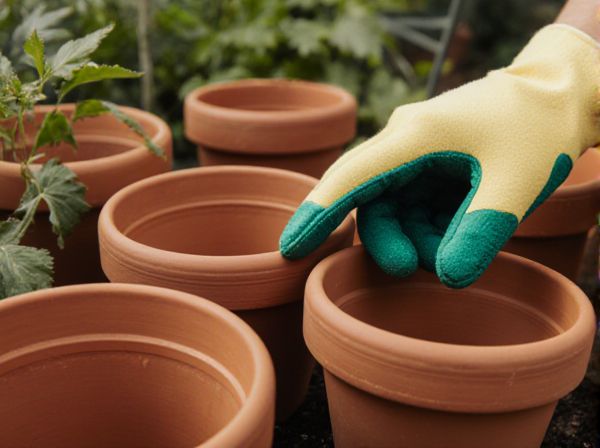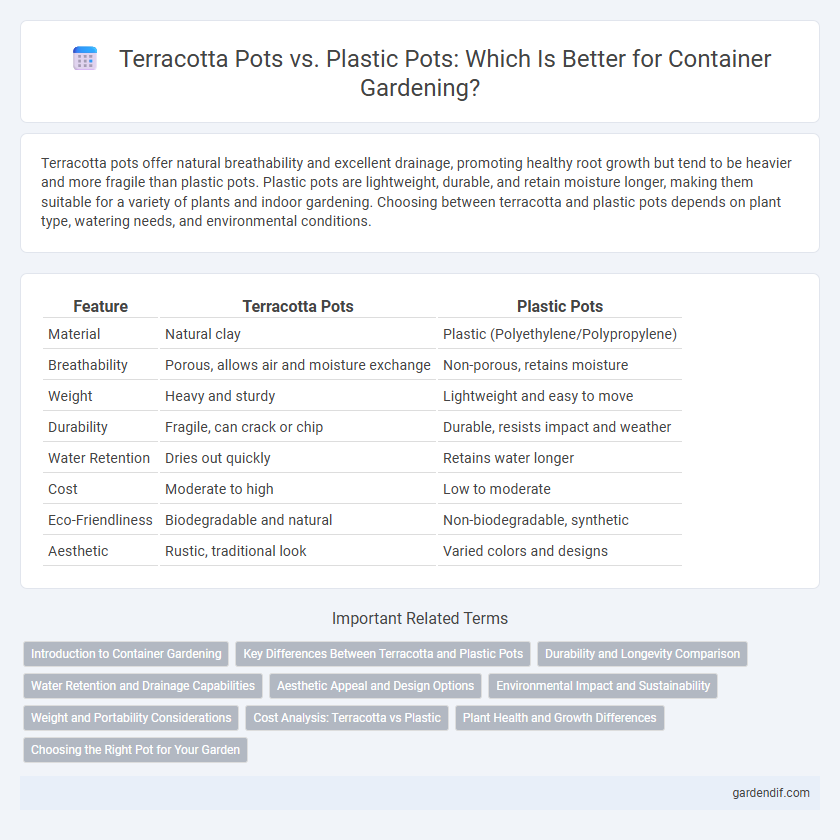
Terracotta pots vs Plastic pots Illustration
Terracotta pots offer natural breathability and excellent drainage, promoting healthy root growth but tend to be heavier and more fragile than plastic pots. Plastic pots are lightweight, durable, and retain moisture longer, making them suitable for a variety of plants and indoor gardening. Choosing between terracotta and plastic pots depends on plant type, watering needs, and environmental conditions.
Table of Comparison
| Feature | Terracotta Pots | Plastic Pots |
|---|---|---|
| Material | Natural clay | Plastic (Polyethylene/Polypropylene) |
| Breathability | Porous, allows air and moisture exchange | Non-porous, retains moisture |
| Weight | Heavy and sturdy | Lightweight and easy to move |
| Durability | Fragile, can crack or chip | Durable, resists impact and weather |
| Water Retention | Dries out quickly | Retains water longer |
| Cost | Moderate to high | Low to moderate |
| Eco-Friendliness | Biodegradable and natural | Non-biodegradable, synthetic |
| Aesthetic | Rustic, traditional look | Varied colors and designs |
Introduction to Container Gardening
Terracotta pots offer natural breathability and moisture regulation for healthier root systems, while plastic pots provide lightweight durability and cost-effectiveness ideal for container gardening. The porous nature of terracotta allows soil to dry out more quickly, reducing the risk of root rot in outdoor settings. Plastic containers retain moisture longer and are versatile for various plant types, making them a popular choice for beginners in container gardening.
Key Differences Between Terracotta and Plastic Pots
Terracotta pots are porous and allow air and moisture to pass through, promoting root aeration and preventing waterlogging, while plastic pots are non-porous, retaining moisture longer and reducing the frequency of watering. Terracotta pots are heavier and more fragile, offering better stability for larger plants but requiring careful handling, whereas plastic pots are lightweight, durable, and more resistant to impact. Temperature regulation differs significantly as terracotta pots can keep roots cooler in hot weather, in contrast to plastic pots, which may retain heat and potentially stress plants.
Durability and Longevity Comparison
Terracotta pots offer superior breathability and natural porosity, which enhances soil aeration but are prone to cracking in extreme weather conditions, limiting their durability. Plastic pots provide greater resistance to impact, weather, and UV rays, ensuring longer longevity and reduced risk of breakage. Choosing between terracotta and plastic depends on prioritizing aesthetic and natural soil benefits versus long-term durability and low maintenance.
Water Retention and Drainage Capabilities
Terracotta pots excel in water retention due to their porous nature, allowing gradual evaporation and preventing waterlogging, which benefits plants requiring moderate moisture levels. Plastic pots, in contrast, offer superior drainage control as they typically have fewer pores but often feature pre-made drainage holes, ideal for plants sensitive to overwatering. Choosing between terracotta and plastic depends on the plant's water needs and the environment's humidity, with terracotta suited for drier conditions and plastic for moisture retention and faster drainage.
Aesthetic Appeal and Design Options
Terracotta pots offer a natural, earthy aesthetic with warm, reddish-brown tones that enhance garden or indoor plant displays, while plastic pots provide a wider variety of colors, shapes, and finishes to suit diverse design preferences. The porous texture of terracotta also adds rustic charm, supporting a more organic look, whereas plastic pots often feature sleek, modern designs with smooth surfaces. Choosing between these containers depends on the desired visual effect and how well the material complements the overall plant presentation and surrounding decor.
Environmental Impact and Sustainability
Terracotta pots are biodegradable and made from natural clay, reducing environmental impact through their ability to decompose without releasing harmful chemicals. Plastic pots, although lightweight and durable, contribute significantly to pollution due to their non-biodegradable nature and reliance on petroleum-based materials. Choosing terracotta supports sustainability by promoting eco-friendly gardening practices and minimizing plastic waste in landfills.
Weight and Portability Considerations
Terracotta pots weigh significantly more than plastic pots, making them less convenient for frequent moving or rearranging. Their heavier weight provides stability, ideal for outdoor use in windy areas, but limits portability for gardening enthusiasts who rearrange plants regularly. Plastic pots offer lightweight and easy-to-handle options, perfect for balconies and indoor gardening where frequent relocation is necessary.
Cost Analysis: Terracotta vs Plastic
Terracotta pots typically incur higher initial costs due to the natural clay material and labor-intensive manufacturing process, averaging around $10 to $30 per pot depending on size. Plastic pots offer a more budget-friendly option, often priced between $2 to $10, making them ideal for large-scale planting or budget-conscious gardeners. However, terracotta pots provide better breathability and moisture regulation, potentially reducing costs associated with overwatering or plant diseases over time.
Plant Health and Growth Differences
Terracotta pots offer superior breathability and moisture regulation, promoting healthier root systems and preventing overwatering-related diseases compared to plastic pots. In contrast, plastic pots retain moisture longer but may lead to root rot and limited oxygen availability, potentially stunting plant growth. Choosing terracotta enhances aeration and natural evaporation, fostering stronger, more resilient plants.
Choosing the Right Pot for Your Garden
Terracotta pots offer excellent breathability and natural insulation, promoting healthy root growth and preventing soil overheating, making them ideal for plants that prefer drier conditions. Plastic pots provide lightweight durability, retain moisture better, and are cost-effective, suitable for plants requiring consistent watering and for easy relocation. Selecting between terracotta and plastic pots depends on your garden's specific plant needs, watering habits, and environmental exposure.
Terracotta pots vs Plastic pots Infographic

 gardendif.com
gardendif.com